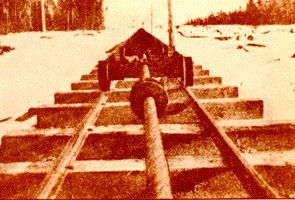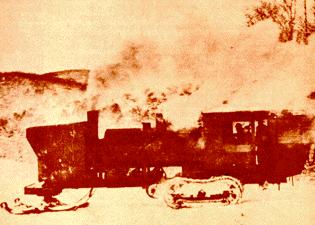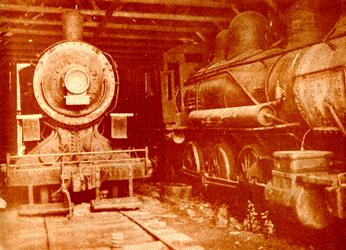Chamberlain Lake Tramway & Trains
Between Chamberlain and Eagle Lake in Maine there are pieces of history that are slowly deteriorating and rusting away. The remnants of two locomotives, steam engine and the sprockets, cable, and train cars can still be found.
You are wondering how all these things go out in the middle of nowhere.
Eagle Lake and Chamberlain Lake Tramway

Original Tramway
In 1902 a tramway was devised to move logs from one lake to another over land so that the logs could be floated down steam to Bangor. The tramway consisted of train style axles attached to a cable that was driven by steam engine and large sprockets. Logs were transported on the axles to Chamberlain Lake were they were dumped into the water for the trip down stream. The tramway moved over 500,000 board feet of pulp per day and was in operation for six seasons starting in 1903.
In 1909 when all the timber was logged at the time to the satisfaction of the paper companies the operations was shut down.
Eagle Lake to Umbazooksus Lake Trains
In the 1920 Canadian logging industrialist Edouard Lacroix, gained the timber rights to the area. Lacrioux faced the same problem as his predecessors. In 1926 they started on the route for a rail system from Eagle Lake, near the old tramway, west across Allagash Stream, down the shores of Chamberlain Lake to the head waters of Umbazooksus Lake. The 13 mile railroad was cut into the forest and construction began. The materials including enough steel for a 1500 foot bridge across the Allagash was hauled in that winter. While the lakes were frozen steam powered Lombard log haulers performed the impossible.

|

|
Lombard log hauler
|
Train
|
The 2 locomotives were purchased used from other points in New England. One was from the Rutland Railroad and the other from the New York Central Railroad. They moved in the two locomotives in pieces on a Lombard log hauler. One locomotive weighed 142,000 pounds and the other 180,000 pounds, and were reassembled in the woods without benefit of a crane. The steam engines were converted to oil and once the railroad was finished they were put into full time operation. The tramway moved over 500,000 board feet of pulp per day and was in operation for six seasons starting in 1903.
The new railroad was then called the U&EL line, for Umbazooksus and Eagle Lake Railroad. The paper companies bought out Lacroix and changed the name to the Eagle Lake and West Branch, but Lacroix was retained to run the operations. In 1927 the system was ready for business and at the two locomotives moved over 100,000 cords of wood that had been cut that past winter. There were 2 tracks at the Eagle Lake loading site and a passing track in the middle of the stretch between the lakes so that the trains could pass each other. The empty train would be filled at Eagle Lake while the full train was emptying its load in Umbazooksus Lake. Switching engines at each end of the line would move the full and empty cars off the locomotives and set them up for the return trip to the other lake.

|

|
Conveyor belt system
|
Dumping logs
|
A conveyor belt system was built at Eagle Lake to load the cars with the winter's waiting pulpwood. The loaded cars would then be hitched to the locomotive for the trip to Umbazooksus Lake.
A long point was built into Umbazooksus Lake with the rail system on top of it. The rail system on the man made point was made with one of the railroad rails six inches higher than the other. This made it so that logs could be dumped easily from the cars into the water for the trip to the mills. The railway ran for 12 hours a day and each cycle of full and empty cars took 3 hours. The railroad operated for over four season until the supply of timber was once again exhausted from the area.

|
Locomotives when parked
|
In 1930 the engines were backed into the repair shed that housed them and their boilers were shut down for the last time. The incredible and nearly impossible task of building and operating a railroad in the heart of Maine's north woods was then abandoned and the forest started to close back in on the railway and the engines.
In 1933, with the country lurching deeper into an economic depression, Great Northern Paper Co. abandoned the railroad. Ever since the trains has been sitting here in the woods, a rusting relic.
The locomotives were originally stored within a shed that has not since rotted away and the locomotives had fallen on there sides. They have since been up righted and places on a stable foundation.
If you were to go and visit the place today you could walk around and find various pieces of the operation. Rails, sections of the cable and the two, large wood-fired boilers that generated the steam are what remains.
Photos taken 30 March 2008 More Photos

|

|

|

|

|

|

|
|
Locomotives
|
Locomotives
|
Head lamp
|
furnace
|
view
|
View
|
Brake
|

|

|

|

|

|

|

|
|
Furnace
|
Locomotives
|
Locomotives
|
Train cars
|
Train cars
|
Train cars
|
View from cars
|

|

|

|

|

|

|
|
Train cars
|
Steam engine
|
Steam engine
|
Steam gears
|
Steam pulleys
|
Steam engine
|







